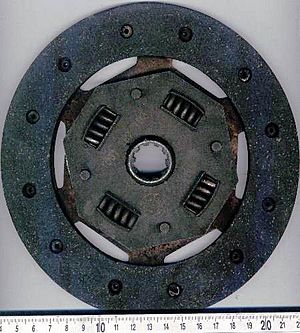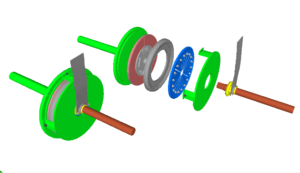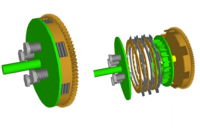Clutch facts for kids
A clutch is a clever mechanical device that helps connect or disconnect two spinning parts, usually a motor and something it needs to power. Think of it like a switch that controls how power flows.
In a car, the clutch connects the engine to the transmission (which helps change gears). When you press the clutch pedal, it disconnects the engine from the wheels. This lets the engine spin freely, even if the car isn't moving or when you're changing gears.
Another example is an electric drill. The clutch lets the drill bit spin with the motor, spin slower, or even stop while the motor keeps going. This is super useful for drilling different materials or when you need to be precise.
Contents
What are the main types of clutches?
Clutches come in different types, each designed for specific jobs. They all help control power, but they do it in slightly different ways.
Dry clutches
Most clutches, especially in cars with manual transmissions, are dry clutches. They use friction to transfer power. Imagine two flat surfaces pressing together – the friction between them makes them spin at the same speed.
When you start a car, the clutch might slip a little. This means it's partly engaged, allowing the engine to gradually send power to the wheels. This helps the car move smoothly without a sudden jerk. However, too much slipping can wear out the clutch faster.
Some dry clutches have springs inside them. These springs help reduce noise and vibrations in the vehicle, making your ride smoother and quieter.
Wet clutches
A wet clutch works similarly to a dry clutch, but its parts are bathed in oil. This oil helps cool the clutch and makes it last longer. It also allows for a smoother connection between the spinning parts.
Because the oil makes the surfaces a bit slippery, wet clutches often have several friction plates stacked together. This helps them grip tightly when fully engaged, even with the oil present. You'll often find wet clutches in motorcycles.
Centrifugal clutches
A centrifugal clutch is pretty cool because it works automatically! It engages (connects) when the engine speeds up and disengages (disconnects) when the engine slows down.
You can find these clutches in small motorcycles, motor scooters, and even chainsaws. They make starting and stopping these machines much simpler, as you don't need a separate clutch lever.
Cone clutches
A cone clutch is like a dry friction clutch, but instead of flat plates, it uses cone-shaped surfaces. The friction material is on the outside of one cone, which fits into another.
A common place to find cone clutches is inside a car's manual transmission, where they help with synchronizing gears for smooth shifting.
Dog clutches
A dog clutch is a type of clutch that doesn't slip at all once it's connected. It uses interlocking "dogs" or teeth to create a solid, non-slip connection between two shafts.
These clutches are used in special types of transmissions where a very strong and direct connection is needed, without any slipping.
Single-revolution clutches
A single-revolution clutch is designed to make a machine's part spin for exactly one full turn and then stop. Imagine a machine that needs to do a precise action, like stamping something, just once when you press a button.
These clutches were used in older machines like teleprinters (machines that printed messages from afar) and tabulating machines (early computers). They ensured that each operation was precise and completed in a single cycle.
How are clutches used in cars?
Clutches are super important for how cars work, especially those with manual transmissions.
Manual transmissions
Most cars and trucks with a manual transmission use a dry clutch. You control it with the pedal on the far left. When you press the pedal, the clutch disconnects the engine from the transmission. This lets you change gears or stop the car without the engine stalling.
The clutch is usually attached to the engine's flywheel, which is a heavy disk that helps the engine run smoothly. The clutch disk itself is made of special materials like organic compounds or ceramics, designed to handle a lot of friction and heat.
Automatic transmissions
In cars with an automatic transmission, you don't have a clutch pedal. Instead, a device called a torque converter handles the job of connecting and disconnecting the engine from the transmission.
However, automatic transmissions often have their own internal clutches. For example, a "lock-up clutch" helps the torque converter work more efficiently, which saves fuel.
Fans and compressors
Clutches aren't just for the wheels! Some older car engine cooling fans use a special clutch that activates when the engine gets hot. This helps the fan spin faster to cool the engine down.
Also, your car's air conditioning compressor often uses a magnetic clutch. This clutch engages the compressor only when you turn on the air conditioning, saving energy when you don't need it.
How are clutches used in motorcycles?
Motorcycles usually have a wet clutch. This clutch shares the same oil as the motorcycle's engine and transmission. It's made of several alternating friction plates and steel plates.
When you pull the clutch lever on the left handlebar, the plates separate, disconnecting the engine from the wheels. This allows you to shift gears or stop. When you release the lever, springs push the plates together, engaging the clutch and sending power to the wheels.
Some racing motorcycles use special "slipper clutches." These clutches help prevent the rear wheel from locking up during hard braking, which can make the bike unstable.
Images for kids
-
A single-revolution clutch inside a teleprinter.
See also
 In Spanish: Embrague para niños
In Spanish: Embrague para niños
- Clutch control
- Coupling
- Freewheel
- Gear shift
- Torque converter
- Torque limiter





